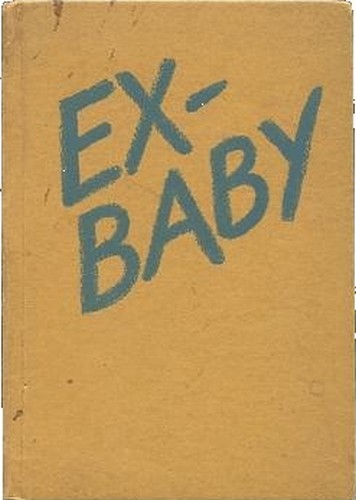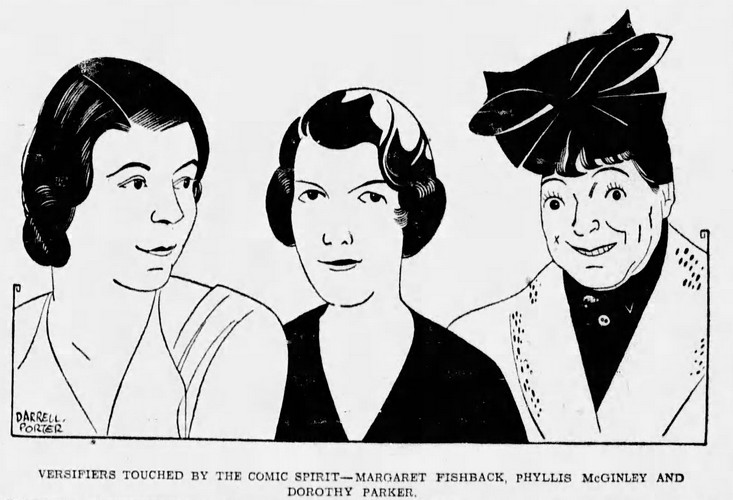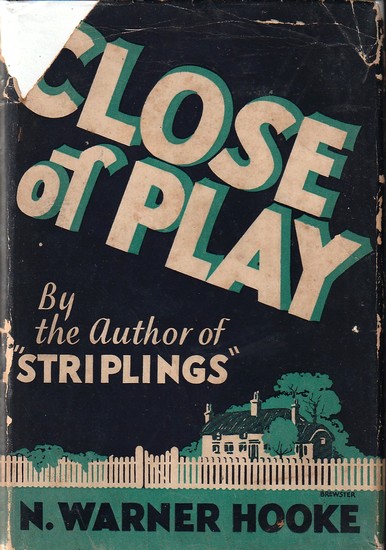
At a time when writers could make small fortunes by selling the film rights to their novels, plays, and magazine stories to studios hungry for scripts for talkies, the biggest fortune by far was that made by Fulton Oursler and his wife Grace. Neither of those names are likely to be familiar to many people today, but they represented a power couple that could take a place beside legendary studio executive Irving Thalberg and his Oscar-winning actress wife, Norma Shearer. In 1932 alone, they sold eight properties to Fox and Columbia — five for Fulton and three for Grace — while continuing to produce a steady flow of best-selling novels and magazine short stories. And, in Grace’s case, giving birth to her second child.
It may help to explain that Fulton Oursler was more than a writer. Back in 1921, Oursler had been hired by Bernarr Macfadden, the physical fitness guru who had stumbled into a gold mine by founding True Story magazine and tapping into two burgeoning trends: America’s fascination with gossip and its consumption of magazines. Although True Story purported to be filled with authentic if lurid tales submitted by general public, Macfadden soon found that while the public might have some great stories, they needed the help of experienced writers to tell them. He hired Oursler, a former newspaper reporter who could produce thousands of publishable words in just a few hours at the typewriter.
Macfadden learned that Oursler had an even greater gift as an editor than as a writer and he turned over most of the day-to-day responsibilities for True Story to Oursler. True Story quickly grew into one of the most popular magazines in America and with Oursler’s help, Macfadden established over a dozen magazines in the next few years, capitalizing on everything from the growth of radio (Radio Stories), the beauty industry (Beautiful Womanhood), and even the brief wave of artistic dance enthusiasm inspired by Isadora Duncan (Dance Magazine). To feed his media machine, Macfadden tasked Oursler to hire what in today’s world we’d call content creators: prolific writers like Oursler. Into the Macfadden Building at 1926 Broadway filed an ensemble that included Vera Caspary (future author of Laura), Nat Pendleton (Olympic wrestler and future Hollywood character actor), and a tenacious young reporter and occasional Broadway actress named Grace Perkins.
Perkins became Oursler’s girl Friday, taking on every job from chasing down gangsters’ molls to posing for the cheesecake photos that were a staple of Macfadden periodicals. And not long after, she became Oursler’s mistress. By 1925, Oursler had decided to end his first marriage, and he and Perkins sailed for France, when Oursler obtained a French divorce and the two married. Oursler continued to run Macfadden’s magazines remotely while in France and managed to finish his third novel, Sandalwood.
Oursler encouraged Perkins to try her hand at creative writing and she began selling stories, starting with “Borrowed Clothes,” which appeared in McClure’s in 1926. Two years later, her first novel, Angel Child, appeared within weeks of Oursler’s fourth, Poor Little Fool. As if life wasn’t busy enough at the Oursler/Perkins apartment (referred to as Sandalwood), publisher and bookstore owner Lowell Brentano, who’d co-authored a thriller play, The Spider, approached Grace about writing a book to capitalize on the success of Ursula Parrott’s scandalous best-selling novel, Ex-Wife. Brentano’s idea was to publish anonymously — as Ex-Wife had been at first — a novel claiming to be the confessions of a long-time “kept woman”: Ex-Mistress.
Although uncomfortable with the subject matter — as her stepson Will Oursler relates in his memoir, Family Story, Perkins’s private morals were considerably more Puritanical than her professional career and affair with Oursler would suggest — she agreed on the condition that Brentano assure her anonymity. Considering that Perkins had spent the last six years working for a tell-all magazine and lived in a city with a gossip columnist on every corner, she should have known that Brentano’s commitment would be short-lived. Although Ex-Mistress first appeared anonymously, subsequent printings were credited to Dora Macy, the book’s narrator, and within a month or two later, Variety and other papers were telling the world that the credit properly belonged to Mrs. Fulton Oursler/Grace Perkins.
Perkins suffered from multiple health problems, and not long after Ex-Mistress was published, she was hospitalized and spent several months in recouperation. Her talks with the nurses who cared for her inspired her to follow the formula of Ex-Mistress — a first-person of a woman who struggles against a series of injustices and obstacles. This time, however, she added a more compelling action. Lora, the nurse, is assigned by her nursing service to care for two young sisters who are, as the medical profession put it at the time, failing to thrive. In reality, they’re being starved to death in a complicated conspiracy involving their wealthy but dissolute mother, her chauffeur, and a corrupt doctor. The obstacles she faces in trying to rescue reveal something of the power structures of the time in that Lora, despite the medical facts on her side, is disparaged by virtually everyone, including her nursing service supervisor and a reputable doctor she seeks out. The doctor, for example, resists becoming involved purely out of collegial discretion.
The film rights to Ex-Wife and Night Nurse were quickly picked up by Warner Brothers, each selling for over $10,000, and Perkins’s next novel, Personal Maid, was sold to Paramount before it was even published. Hungry for strong stories on shocking subjects, the studios found Perkins’s work ideal — and her prominent connection with Macfadden’s magazine empire, which now included Liberty, provided an easy way to broaden the reach of their publicity. Of the three film versions, Night Nurse is, by far, the most faithful to Perkins’s original. My Past, on the other hand, jettisoned almost everything except the heroine’s name — and even that was mutated to Doree Macy.
By the summer of 1932, the lure of movie money had become too strong to resist, and the Ourslers moved to Hollywood, renting a large house from actor Jack Holt. Oursler continued to manage the editorial affairs of Macfadden Publications and work on Thatcher Colt mystery novels he published as Anthony Abbott, several of which were made into movies, as was The Spider. Ironically, living in America’s capital of illusions sparked Perkins’s interest in writing a story that dealt more directly with the nation’s economic problems: the Wall Street crash of October 1929 and the resulting depression.
No More Orchids opens in November 1929, just a few weeks after the crash. Anne Holt, daughter of a banker and granddaughter of one of the richest men in America, arrives in Cherbourg by seaplane to catch the steamship that’s delayed its departure while she partied in Paris. She offers no apology to the captain, knowing his concern for schedule takes a back seat to his fear of provoking the grandfather’s wrath, and immediately dives into a bridge game with a band of friends. “Card playing was the hardest work any of us did,” Ann reflects. Short on hard cash when she loses, she pays her debt by handing over a $10,000 diamond bracelet. Money means as little to Ann as air.
Her attitude especially repels one of the ship’s passengers. Tony Gage, the manager of a coffee plantation in Brazil (owned, it turns out, by Ann’s grandfather), finds her carelessness about money abhorrent. Unfortunately, the two of them also feel a powerful physical attraction, and by the time they land in New York, a fierce love-hate relationship is underway, with love steadily gaining the upper hand.
Anne’s holiday comes to an abrupt end. Her sister, in an unhappy marriage, has had an affair, followed by an abortion, and has taken to smoking cocaine-laced cigarettes. Anne’s grandfather is holding her inheritance hostage to her agreeing to marry a European nobleman. And his leverage has increased thanks to the impending failure of her father Bill’s bank. “The whole world will hear of it — for there isn’t a chance, not a chance, that he could pull out clean,” he informs her, delighting in the prospect of seeing the son-in-law he despises ruined. Marry the prince, however, and the grandfather will not just release Anne’s inheritance but bail out her father. Thus, Anne’s dilemma is set: will she choose love or money and her father’s rescue?

We reach this cliffhanging moment roughly one-third of the way into the book. Between here and the eventual happy ending, Perkins seeds a half-dozen more plot twists and quandaries, betraying a factor that influenced the book every bit as much as artistic intention: its serialization. No More Orchids appeared in ten installments in Liberty magazine between mid-June and mid-August 1932. In keeping with the traditions of magazine serials, it was incumbent upon Perkins to close each installment with enough dramatic tension to bring the readers back the next week. At the end of the ninth installment, in the August 13, 1932 issue, for example, readers were informed, “In next week’s concluding installment you’ll witness the great climax that decides whether life is to hold frustration or happiness for Anne.” In this way, the narrative arc of a serialized novel more closely resembles the trajectory of an artillery shell than Aristotle’s three-act story structure. Nine-tenths of the way into the novel, we still don’t know “whether life is to hold frustration or happiness for Anne.” Everything will come together in the final installment.

The film rights to No More Orchids were sold to Columbia in early June 1932, before the serial even began running in Liberty, and the book edition of the novel was released by Covici-Friede in late July, when seven out of ten installments had appeared. The film version, starring Carole Lombard, was released in late November, concurrent with a second book edition, this time with photos from the film, in the “Photoplay” movie tie-in series that Grosset and Dunlap had been publishing since Harold MacGrath’s The Adventures of Kathlyn in 1913.
No More Orchids offers an illuminating example of how each medium — book, magazine, and movie — adapted the same underlying story to its purposes. From a plot standpoint, there is little difference between the book and magazine serial versions, but Perkins had to trim her structure and prose for Liberty. The book’s sixteen chapters are condensed into ten installments, with color being the chief victim of the cut. Here, for example, Anne, recuperating from an emergency appendectomy (another cliffhanger), observes her Maine farm-wife grandmother:
And as I got better I’d pretend that I was asleep, and then fall to studying her with endless inspection…. She wasn’t ugly! [Anne’s mother had called her mother-in-law ugly.] Nobody could call her a beauty, but she certainly wasn’t as repulsively decayed as my memory pictured her. There were moments when she was almost lovely. I searched her for signs of resemblance to Bill, and often there were phrases she used, and tonalities, that brought him back to me so sharply that I could feel my lips forming his name.
The Liberty version drops that last sentence, and similar elisions can be found in almost every paragraph of more than three or four sentences. It’s much the same editorial approach one finds in Reader’s Digest condensed books: triage. Keep the plot, patch up the dialogue, sacrifice the long descriptions. The extent of the damage this triage does to a text is perhaps evidence of its artistic integrity: one shudders to think how it would ruin Remembrance of Things Past; No More Orchids, on the other hand, might actually have benefited from it. Grace Perkins mostly writes in terse, telegraphic sentences, her dialogue ping-pongs among her characters. I’m not sure Gran’s “tonalities” are worth preserving.

If the magazine version of No More Orchids required Perkins to trim her prose a bit, the film version called for some serious machete work. Keene Thompson was first assigned as screenwriter, but in September, with the serial complete and the book version published, Columbia called in Gertrude Purcell to tailor the story to the strengths of its three leads: Carole Lombard (Anne), Lyle Talbot (Tony), and Walter Connolly (Bill). Between them, Thompson and Purcell jettisoned at least 70% of Perkins’s material.
Much of the second half of the novel takes place in the aftermath of Bill’s suicide. Anne having refused her grandfather’s deal, Bill heads to Washington, D.C. in hopes of raising money to keep his bank afloat. Failing, he shoots himself, and Anne finds herself destitute, struggling to find work and survive. Her romance with Tony runs into its share of obstacles. She flees to the safety of her grandmother’s farm, only to see it consumed in a forest fire. In the last chapter, a letter from Bill materializes with evidence that will send her evil grandfather to jail for fraud, restoring Bill’s posthumous reputation, and Anne and Tony reunite, marry, and head off to South America to live happily ever after.
All of this gets ditched in the film. Anne never has to go hungry or fight a forest fire or have an emergency appendectomy in a Maine train station because the scriptwriters manufacture a deus ex machina that allows all that dramatic clutter to be bypassed. Bill takes out an enormous life insurance policy and then flies his plane into a mountain, thereby resolving the bank crisis and enabling the lovers to reunite, etc..
Many studies have been written about the art or craft of adapting fiction to film. Most take books that most of us would consider classic, or at least respectably solid — say, the novels of Jane Austen — and note the various ways in which the complexities, nuances, and riches are lost in translation to the screen. But one could just as easily take a lesser book — and No More Orchids is certainly far inferior to Pride and Prejudice — and ask, what’s gained?
Just comparing the book and film versions of No More Orchids and their near-contemporaries in Big Business Girl, which I wrote about recently, I would argue that little that’s lost between page and screen in No More Orchids is worth mourning. There is a lot of narrative thrashing, particularly in the second half, that is intricate choreography but not fundamentally revealing of character or context. With the film version of Big Business Girl, on the other hand, the entire subplot of dry-cleaning rackets, hijacking, murders, and bombings is lost, and the story is reduced to a familiar formula: will Priscilla marry Miles Standish or John Alden? Either way, Priscilla’s going to have to quit her job and become a happy homemaker.
Grace Perkins and Fulton Oursler stayed in Hollywood for a year or so after No More Orchids, both contributing dialogue and picking up a few more film rights sales. Perkins’s story “Mike,” which appeared in Liberty in May 1933, came out as Torch Singer, starring Claudette Colbert, a few months later. They returned to New York and carried on their successful magazine careers, Oursler moving from Liberty to Reader’s Digest in the early 1940s. Oursler and Perkins both embraced religion around the same time and Oursler had an enormous bestseller in The Greatest Story Ever Told, which took a serial magazine story approach to the life of Jesus Christ (and which was filmed in 1965). Perkins wrote three more novels after No More Orchids, but none were picked up by the studios. Oursler died in 1952; Perkins died three years later after sustaining injuries in a fall.





























































